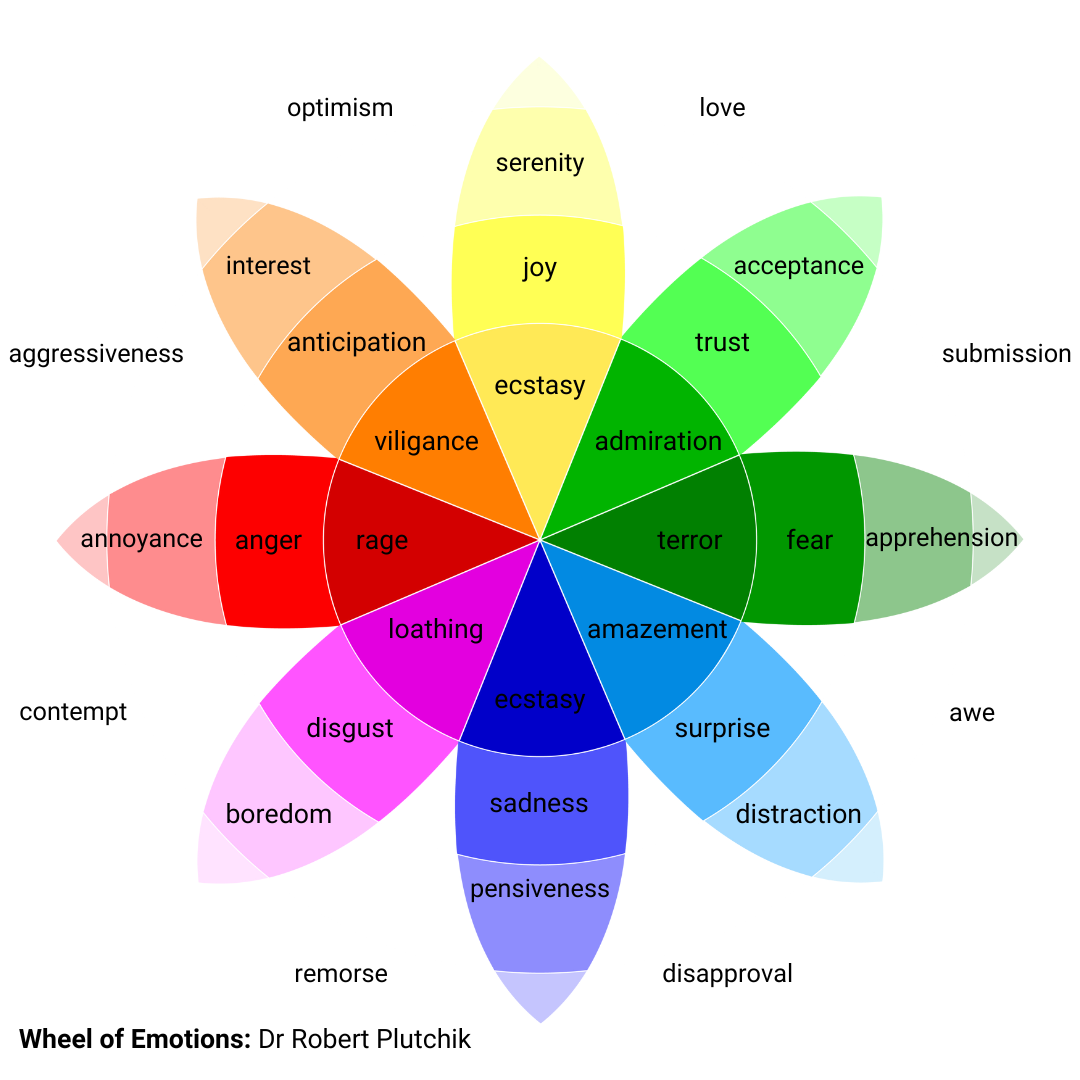
“Feelings are the language that wisdom uses to speak to us.” – Judith Glaser
Emotions demonstrate our humanity
With the emphasis on technology and virtual communication, many people are becoming less adept at handling interpersonal conversations and managing their emotions.
However, emotions are more valuable than ever in the age of AI. Our feelings express our humanity. ChatGPT and other machine learning tools bypass inner thoughts and go straight to content. They may work at speed, but they miss out on experience, knowledge, interpretation and creativity. They’re fed by the mass population, not the brilliance that could be in any individual’s head at that moment in time. Which means it’s more important than ever before for us to get to know our own emotional landscape and use it to our advantage at work.
Defining emotions
In my second book, Power Up, I looked at the skills that make up ‘power’. One of the key things I identified as a super power is the ability to tap into emotions – to access them and channel them appropriately.
There’s been a lot of research into human emotions. I particularly like the work by Dr Robert Plutchik which goes back to 1980. He devised the ‘emotions wheel’ as part of his Psycho-evolutionary Theory of Emotion.
According to Plutchik, there are eight core emotions, each of which sub-divides into more and more nuanced expression, which he presented in an emotion wheel.

1. Joy
2. Trust
3. Fear
4. Surprise
5. Sadness
6. Disgust
7. Anger
8. Anticipation
This tool is very useful to better understand our emotions and those of others. For example, if you’re ‘feeling a bit off’ but don’t really know why, you could get some useful clues by boiling it down to its most basic emotion (see list above). Or you could identify a more sophisticated emotion by combining two of the basic ones, eg: Joy + Trust = Love; Fear + Surprise = Alarm. And then get even more precise by combining first/second tier emotions to create a third tier.
A key point to bear in mind here is that there’s no such thing as a ‘wrong’ emotion. You feel what you feel, and all feelings are part of the human experience. The secret is using your emotions to drive your self-development, tapping into them rather than allowing them to drive you.
Emotional intelligence is a super-power
I ran a leadership course a few years ago for an investment bank. Most of the attendees prioritised action over reflection and rolled their eyes when I mentioned emotional intelligence (EI). They thought it was a ‘fluffy’ thing.
Thankfully, most organisations have since recognised the value of EI and the benefit of leaders, managers and teams becoming more emotionally conversant. When people communicate using EI, it can help inspire and increase engagement. When communication goes wrong, it’s often because emotions were not heard or understood.
So what is EI?
Also known as EQ (or Emotional Quotient) EI is the ability to understand your own emotions and manage them, while also being able to put yourself in the other person’s shoes and understand their emotional landscape, finding a way that respects and accepts both.
Emotional versatility
In Power Up, I explore my idea of emotional versatility. That is, the ability to really pinpoint and label how you are feeling, beyond the eight base emotions.
Becoming more emotionally fluent enables you to tap into the vast universe of human experience and therefore more able to appreciate, replicate, share and build on those emotions you enjoy, and equally, channel, learn from or take steps to avoid those emotions which are painful.
This isn’t to say that we should ‘skip over’ uncomfortable emotions, as they hold a wealth of wisdom and learning. But neither should we dwell or ruminate if we realise an emotion is zapping our energy or preventing us from feeling any kind of joy. And it’s worth bearing in mind that if you’re living with painful emotions over an extended period of time, it’s important to talk to a loved one and seek guidance from a trained professional who can help you get the support you need.

Tapping into emotions at work
Becoming emotionally literate at work is a great way of engaging and building trust in your team. For example, you might be about to share information about changes coming up in the future and anticipate that they’ll be fearful. Rather than leaving them to draw their own conclusions or deal with their fear alone, you could use emotional literacy to label their feelings, and gently lead them beyond them. You could say:
“As I’m thinking about working together on this, I appreciate that you may be feeling fearful. However, moving on from the apprehension, I am confident that by working together we’ll find a way through it. And as I look to the future, I can imagine the excitement we’ll feel when the goal is getting closer, the elation when we get there, and the thrill and jubilation after we’ve achieved it. And I believe we can do that together.”
By articulating the wider breadth of specific emotions, you’re likely to engage more people and bring them along with you on the journey.
Dealing with difficult emotions at work
As well as finding ways to amplify positive emotions at work, it’s important to acknowledge that we experience a gamut of painful emotions there too. We don’t choose our colleagues, and may not have the easiest rapport with stakeholders and so it’s not surprising that interactions can leave us feeling emotionally bruised.
Based on my coaching conversations over the years, the most commonly experienced ‘negative’ emotion in the workplace is fear. For example, it can be the main reason behind resistance to change. People are not often given space to have their emotions heard at work. This can lead to feelings of sadness and fear from not being accepted, acknowledged, respected or appreciated.
Sadness and fear can be perceived by ourselves and others as expressions of weakness and vulnerability which we might prefer to ignore or conceal from others. You might be afraid of sharing “I feel sad” or “I feel fearful” because you’re worried the other person will feel disgust because it taps into something they don’t want to deal with.
Bottom line, you can’t eliminate the emotion, so you need to find a way through. So lead by example, create an environment of psychological safety by talking about it. Fear or sadness are telling you there is something serious that you need to acknowledge and it’s important to do the work on a personal level to explore where those feelings are coming from so they don’t have the power to de-rail you.
Expressing extreme emotion
As well as uncomfortable emotions, there may be time at work where you experience a powerful upsurge of extreme emotion. Anger can get in the way of effective communication. It’s often suppressed, but the fight-or-flight response bubbles up anyway and the other person will pick it up and feel something in return.
No matter how much you try to manage those feelings, the micro-expressions on your face give them away. Beyond the unguarded expressions that flit across your face, you could also use a harsh tone or aggressive body language. You might be tempted to swear or say something inappropriate or offensive to the other person. Swearing is highly disrespectful and won’t help you reach them in an acceptable way that makes your point and gets you heard.
It might be hard, but it’s important to learn how to articulate difficult feelings and do something about it. Extreme emotions have a place. They need to go somewhere. It’s not about burying them. It’s about recognising them and channelling them appropriately.
For more on this, you might like to read my articles about:
• Handling difficult conversations at work
• Is swearing at work acceptable
• Swearing in the workplace

Articulating your feelings
Rather than allowing negative emotions to take over, use language to label how you feel. If you feel sad or fearful, bring it into the conversation, and invite the other person to look at it. For example:
• “I’m feeling upset. I wonder what that’s about?”
• “There’s something about this conversation which is frustrating me.”
• “This situation is triggering the emotion of anger in me, and I’m curious about why that might be.”
You can then explore the solution together.
Practical tips
To become more emotionally aware, become an observer of yourself, noticing your actions, the thoughts in your mind, and the feelings in your body. Give yourself space and time for reflection. You can’t do this if you’re always rushing about, so take time out to decompress and reflect on your emotional tapestry.
When you get triggered or something doesn’t feel right, step out of the situation and look objectively at what you’re feeling and why. Boil it down to one of the eight core emotions from the wheel or pinpoint a collection of more nuanced emotions.
To move beyond the conflict, take a helicopter view and think about what’s going on for the other person.
Then, don’t wait for the other person to invite you to dance (metaphorically). Step out onto the dancefloor and invite them to join you. Have an objective conversation about your experience of emotions. Bring in some humour if you can. Make it pleasurable so they will be comfortable to stay there and dance with you rather than running away. If you go first, you will make it OK. Just believe you can move through together.
By taking command and channelling how you feel, you will become more able to create more of the positive emotions and fewer of the negative ones, and enjoy a wiser and more enriching life.
What next?
To find out more about our coaching packages:
• Book executive coaching
• Talk to us about create a bespoke programme for your leaders

About the author
Antoinette Dale Henderson is a leadership coach, speaker, and author specialising in executive presence and gravitas. With over 25 years in communications, she empowers leaders to increase their influence and impact through her Gravitas Programme and best-selling books, Leading with Gravitas and Power Up.

